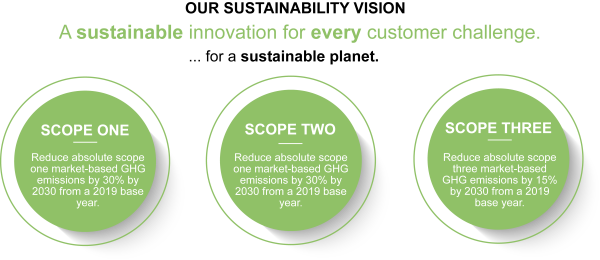Building a Better Tomorrow, Together.
Every Choice Matters.
Every day, our products inspire and support the transition to a more sustainable way of life, from our innovations in energy reducing solutions to our manufacturing equipment that has enabled canmakers to reduce aluminum usage in beverage containers. While our products facilitate a more sustainable future, it’s also important to look at our global environmental impact. By analyzing our own operations, including the sources of the material we consume and our products’ eventual use, we can get a more complete picture of our impact on sustainability.

Change Starts Here.
Belvac, in partnership with Dover, is dedicated to achieving the above monumental goals. We strive to reduce not only our Scope One and Two market-based Green House Gas (GHG) emissions by 30%, but also our Scope 3 market-based GHG emissions by 15%. With our innovative technology and forward-thinking culture, we are ready to help our customers with more impactful solutions for the environment. As the demands in the industry move towards more sustainable and renewable technology, Belvac is continually researching, developing, and adapting to these needs. A great example being the Servo Belvac Necker, which was unveiled in May 2023. The Servo Necker is the future of sustainable Necking operations as it eliminates the gear drive and oil bath and replaces them with Servo motors. This innovation offers customers a 15% reduction in energy consumption for machines running continually throughout the year. While this technology may have had the biggest impact on reducing emissions, it’s not the only sustainable technology Belvac has produced. With many Value Engineered Machines, Kit Upgrades, and Assemblies our team is always on the lookout for opportunities to reduce our environmental impact and limit GHG emissions.
In addition to reducing Scope One and Scope Two emissions, Belvac has many other sustainability initiatives in place, such as looking for alternative sustainable packaging options, finding options to reduce inbound shipments to reduce emissions and increasing recycling efforts among our employees. Recently, the Belvac leadership team in conjunction with our EHS manager have set a goal for our largest three manufacturing locations to become zero waste by 2030.
“In addition to reducing our Scope One and Two GHG emissions, Belvac is dedicated to lowering our overall carbon footprint. We understand the importance of sustainable business operations and have set a goal to make our three largest manufacturing locations net zero waste by 2030.”
– David Mammolenti, President
Throughout our history, our commitment to corporate responsibility and sustainability has created significant value for Belvac and Dover. In 2020, we began implementing a three-year plan to expand our Environmental, Social, and Governance (ESG) disclosures, metrics, goals, and oversight. This journey commenced after extensive dialogue with our stakeholders and with the strong support of and collaboration with our Board of Directors. We pursue sustainability initiatives that support our employees, customers, and communities to ensure our businesses continue to create long-term value for everyone. Our five strategic topics are a subset of our eighteen ESG areas of focus that define the topics that are more important to our business and our stakeholders, including shareholders, employees, suppliers, and customers.